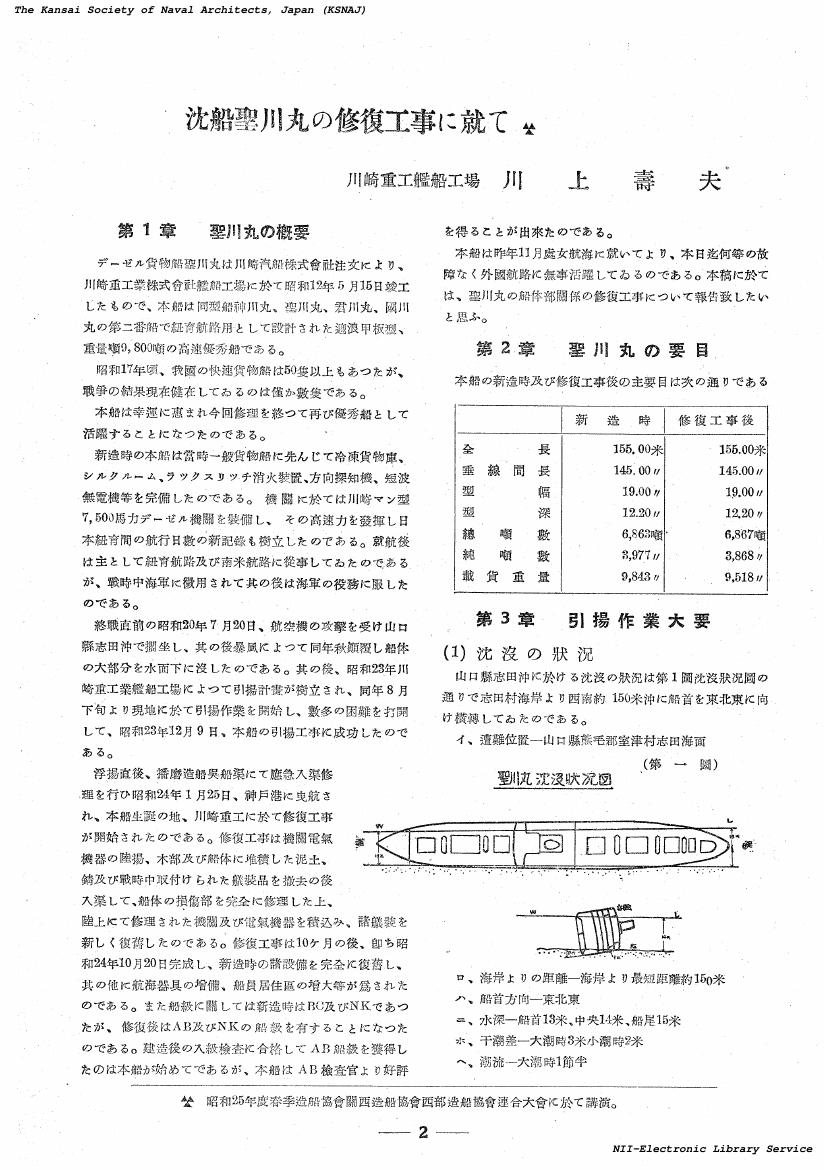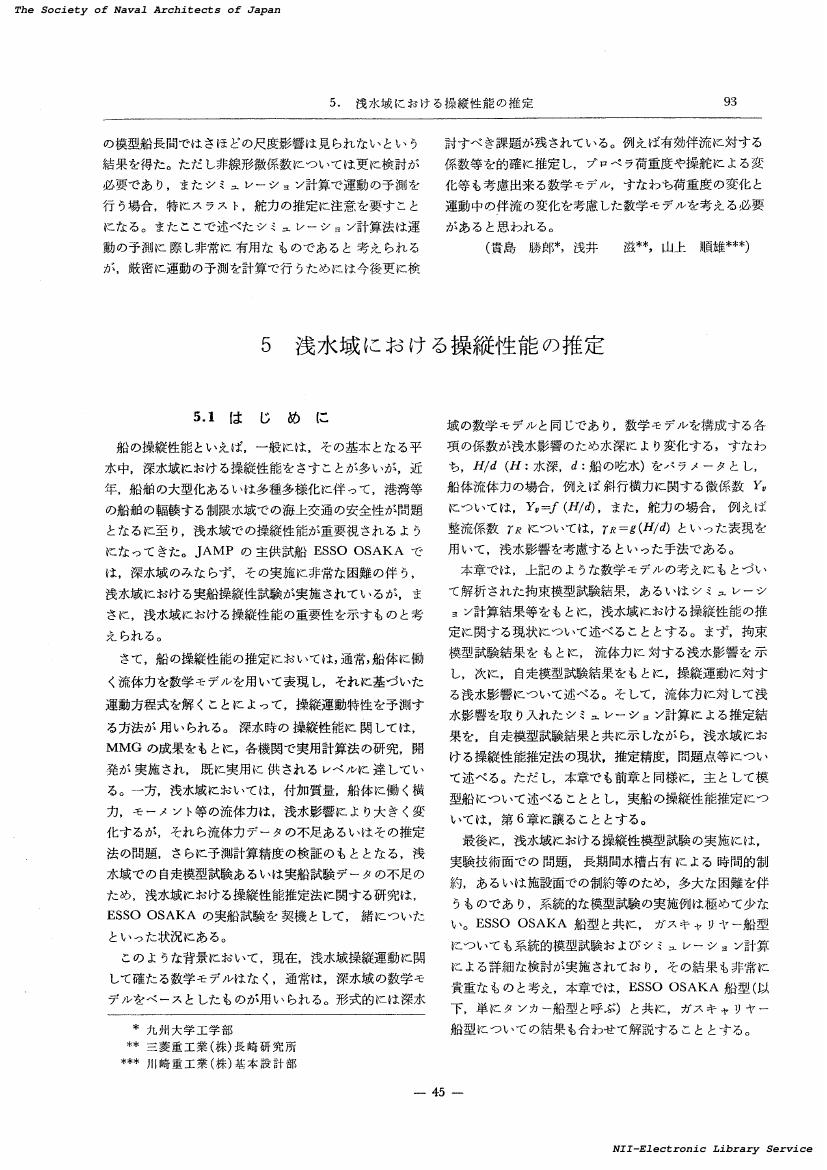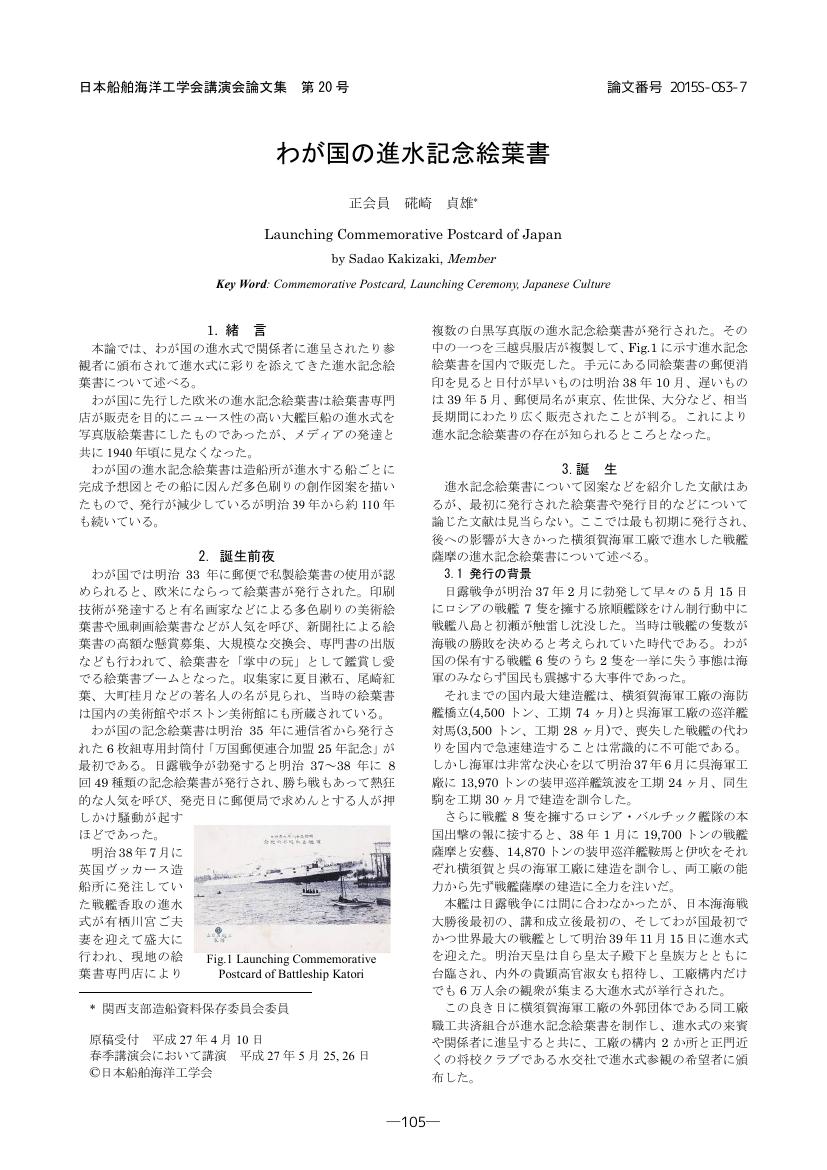4 0 0 0 OA 船舶の曳航能力と曳航安全率に関する研究
- 著者
- 黒田 貴子 原 正一 松田 秋彦
- 出版者
- 公益社団法人 日本船舶海洋工学会
- 雑誌
- 日本船舶海洋工学会論文集 (ISSN:18803717)
- 巻号頁・発行日
- vol.6, pp.339-345, 2007 (Released:2008-03-18)
- 参考文献数
- 8
In order to make a plan of ship towing, it is necessary to investigate the towing performance of the tow ship, status of the towed ship, external force acting on the towed ship and sea conditions. The factors of the towing performance are derived from the towing gear and main engine power, which are evaluated by the bollard pull test in the case of the tugboat. When the general ship instead of the tugboat makes a towing operation, the towing performance with the main engine power is crucial. It is important to know the towing performance of the tow ship and tow force depending on the size of towed ships in several sea states in the emergency towing by the general ship.The bollard pull test and towing test in calm and rough seas have been carried out to investigate the tow force and tow power, critical tow force and the condition of safe towing. The towing safety factor is defined by the critical tow force divided by the maximum towline tension during towing. The factor less than 1 indicates the disability of towing. The critical condition is shown by the value between 1 and 2. Lastly its value larger than 2 indicates the safe towing. The towline tension is calculated by the Optimum Towing Support System developed by the National Maritime Research Institute. In this calculation, the patrol vessel as tow ship tows 5kinds of ships in several sea states. By using the ratio of critical tow force and calculated towline tension, the towing safety factor is estimated and the chart for the critical towing performance in several sea states using the displacement ratio between tow and towed ship has been shown. Even the operator of the general ship will be able to know the possibility of the safe emergency towing using the displacement of the towed ship in certain weather condition in this chart.
4 0 0 0 OA 深海潜水調査船しんかい6500の運動性能について
- 著者
- 高川 真一 難波 直愛 森鼻 英征 手塚 久男 前田 逸郎 重国 清 石黒 慎二
- 出版者
- 公益社団法人 日本船舶海洋工学会
- 雑誌
- 関西造船協会誌 216 (ISSN:03899101)
- 巻号頁・発行日
- pp.201-207, 1991-09-25 (Released:2018-04-01)
Deep Submergence Research Vehicle "SHINKAI6500" is the latest manned research vehicle which can dive to the deepest existing in the world. The maneuverability of a submersible vehicle is highly dependent on its cofiguration. During the development of "SHINKAl6500" we have assumed great importance to its decending and ascending capability. "SHINKAI6500"'s configuration has been improved in various respects reflecting "SHINKAI2000"'s operation results, finally determined based on the results of twice wind tunnel tests and a tank test. In sea trials it is confirmed that hydrodynamics resistance of "SHINKAI6500" is remarkably reduced compared to that of "SHINKAI2000". This paper describes the outline of these model tests, sea trials and the process of the development of its streamlined cofigulation.
4 0 0 0 OA 沈船聖川丸の修復工事に就て
- 著者
- 川上 壽夫
- 出版者
- 公益社団法人 日本船舶海洋工学会
- 雑誌
- 関西造船協会会誌 (ISSN:24331058)
- 巻号頁・発行日
- vol.68, pp.2-14, 1950-12-30 (Released:2018-03-01)
4 0 0 0 OA がんばれ!日本の客船 : 豪華なだけが客船じゃない(サロン)
- 著者
- 渋谷 晶子
- 出版者
- 公益社団法人 日本船舶海洋工学会
- 雑誌
- Techno marine 日本造船学会誌 (ISSN:09168699)
- 巻号頁・発行日
- vol.870, pp.118-123, 2002-11-10 (Released:2018-03-28)
- 参考文献数
- 3
4 0 0 0 OA 波浪貫通型双胴船におけるデッキ上の車両転倒に関する研究
- 著者
- 桃木 勉 長野 真二郎 池田 良穂
- 出版者
- 公益社団法人 日本船舶海洋工学会
- 雑誌
- 日本船舶海洋工学会論文集 (ISSN:18803717)
- 巻号頁・発行日
- vol.9, pp.257-264, 2009 (Released:2009-10-08)
- 参考文献数
- 5
Recently, fast car ferries of catamaran type have become larger and larger. In beam waves, motion of catamaran is relatively severe because of its large stability. Therefore, in beam waves, tilt or turn over of cars is concerned for such catamarans. If relationship between wave height and tilt of cars is clarified, safety voyage without lashing will be able to judge before sailing from port.A method of judgment of tilt of cars on deck was proposed by Kuwano. In this method, however, only rolling motion is taken into account. It is necessary to take other motions into account for higher precision of the judgment of tilt of cars on deck. A new method considering heave, sway and pitch as well as roll motion is developed in the present paper. Model experiments to check out the relevance of the new method and the effect of motions except rolling on behavior of vehicles on decks are carried out.The method is applied to a 112m wave piercing catamaran, and criteria of wave height for tilt of vehicles on decks are predicted.The predicted results demonstrate the effects of other motions except rolling are significant in some cases. It is confirmed that the most critical wave period of tilt of vehicles on decks of the wave piercing catamaran is about 6.0 to 8.0 seconds.
4 0 0 0 OA 3軸2舵の180トン型高速巡視船について
- 著者
- 染矢 隆一
- 出版者
- 公益社団法人 日本船舶海洋工学会
- 雑誌
- 日本造船学会誌 (ISSN:03861597)
- 巻号頁・発行日
- vol.730, pp.204-207, 1990-04-25 (Released:2018-04-05)
4 0 0 0 OA 5浅水域における操縦性能の推定(<特集>船の操縦性能の推定)
- 著者
- 平野 雅祥 湯室 彰規 野中 晃二 小林 弘明
- 出版者
- 公益社団法人 日本船舶海洋工学会
- 雑誌
- 日本造船学会誌 (ISSN:03861597)
- 巻号頁・発行日
- vol.668, pp.93-105, 1985 (Released:2018-03-30)
4 0 0 0 OA 古今(こきん)用語撰
- 著者
- 池田 勝
- 出版者
- 公益社団法人 日本船舶海洋工学会
- 雑誌
- らん:纜 (ISSN:09160981)
- 巻号頁・発行日
- vol.22, pp.19-22, 1993-12-30 (Released:2018-02-24)
4 0 0 0 OA 感動の瞬間
- 著者
- 山崎 健太郎
- 出版者
- 公益社団法人 日本船舶海洋工学会
- 雑誌
- らん:纜 (ISSN:09160981)
- 巻号頁・発行日
- vol.41, pp.80, 1998-10-30 (Released:2018-02-25)
- 著者
- 平川 嘉昭 平山 次清 高山 武彦
- 出版者
- 公益社団法人 日本船舶海洋工学会
- 雑誌
- 日本船舶海洋工学会講演会論文集 (ISSN:18806538)
- 巻号頁・発行日
- vol.5, pp.107-110, 2007
- 被引用文献数
- 1
- 著者
- 小宮 治彦 米澤 雅之 龍田 英世 小川 和夫
- 出版者
- 公益社団法人 日本船舶海洋工学会
- 雑誌
- Techno marine 日本造船学会誌 (ISSN:09168699)
- 巻号頁・発行日
- vol.865, pp.56-61, 2002
4 0 0 0 艦船に装備せる飛行機の射出機
- 著者
- D.O.
- 出版者
- 公益社団法人 日本船舶海洋工学会
- 雑誌
- 造船協会雑纂
- 巻号頁・発行日
- vol.211, pp.801-803, 1939
- 著者
- 新開 明二 硴崎 貞雄 小松 武邦 三好 章夫 森 俊哲 高木 祐介
- 出版者
- 公益社団法人 日本船舶海洋工学会
- 雑誌
- 日本船舶海洋工学会講演会論文集 26 (ISSN:24241628)
- 巻号頁・発行日
- pp.85-89, 2018-05-21 (Released:2023-01-24)
3 0 0 0 OA 徳川武定先生と鬼頭史城先生
- 著者
- 山本 善之
- 出版者
- 公益社団法人 日本船舶海洋工学会
- 雑誌
- Techno marine 日本造船学会誌 (ISSN:09168699)
- 巻号頁・発行日
- vol.857, pp.812-814, 2000-11-25 (Released:2018-03-28)
3 0 0 0 OA アジマス推進器について ─電気推進システムへの対応─
- 著者
- 三嶋 孝洋
- 出版者
- 公益社団法人 日本船舶海洋工学会
- 雑誌
- 日本船舶海洋工学会誌 KANRIN(咸臨) (ISSN:18803725)
- 巻号頁・発行日
- vol.66, pp.17-21, 2016-05-10 (Released:2017-01-26)
- 参考文献数
- 2
3 0 0 0 OA 観光潜水船 "もぐりん" について
- 著者
- 三菱重工業(株)神戸造船所
- 出版者
- 公益社団法人 日本船舶海洋工学会
- 雑誌
- らん:纜 (ISSN:09160981)
- 巻号頁・発行日
- vol.6, pp.51-52, 1989-12-30 (Released:2018-02-24)
3 0 0 0 OA 3 船舶へのFSWの適用について : 海外及び国内の動向(<ミニ特集>摩擦攪拌接合)
- 著者
- 志水 栄一 奈良 圭祐
- 出版者
- 公益社団法人 日本船舶海洋工学会
- 雑誌
- 日本船舶海洋工学会誌 KANRIN(咸臨) (ISSN:18803725)
- 巻号頁・発行日
- vol.5, pp.53-55, 2006-03-10 (Released:2018-03-30)
3 0 0 0 OA 2017A-GS5-16 水素生産帆船の研究 -概念と可能性-
- 著者
- 大内 一之 ジョール ヘンジー
- 出版者
- 公益社団法人 日本船舶海洋工学会
- 雑誌
- 日本船舶海洋工学会講演会論文集 25 (ISSN:24241628)
- 巻号頁・発行日
- pp.717-720, 2017-11-27 (Released:2023-01-06)
3 0 0 0 OA 1.小笠原TSL事業の概要と将来展望(<特集>高速船の動向)
- 著者
- 柴原 三朗
- 出版者
- 公益社団法人 日本船舶海洋工学会
- 雑誌
- らん:纜 (ISSN:09160981)
- 巻号頁・発行日
- vol.64, pp.1-6, 2004-06-30 (Released:2018-03-01)
3 0 0 0 OA 2015S-OS3-7 わが国の進水記念絵葉書
- 著者
- 硴崎 貞雄
- 出版者
- 公益社団法人 日本船舶海洋工学会
- 雑誌
- 日本船舶海洋工学会講演会論文集 20 (ISSN:24241628)
- 巻号頁・発行日
- pp.105-108, 2015 (Released:2018-01-17)













